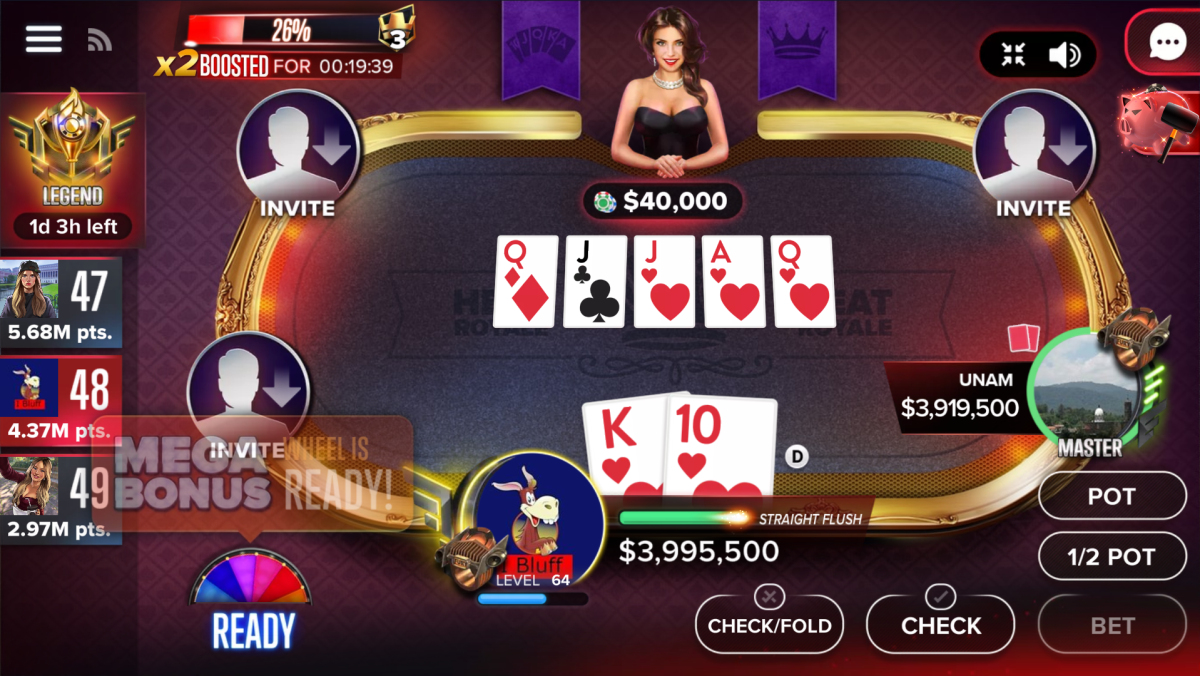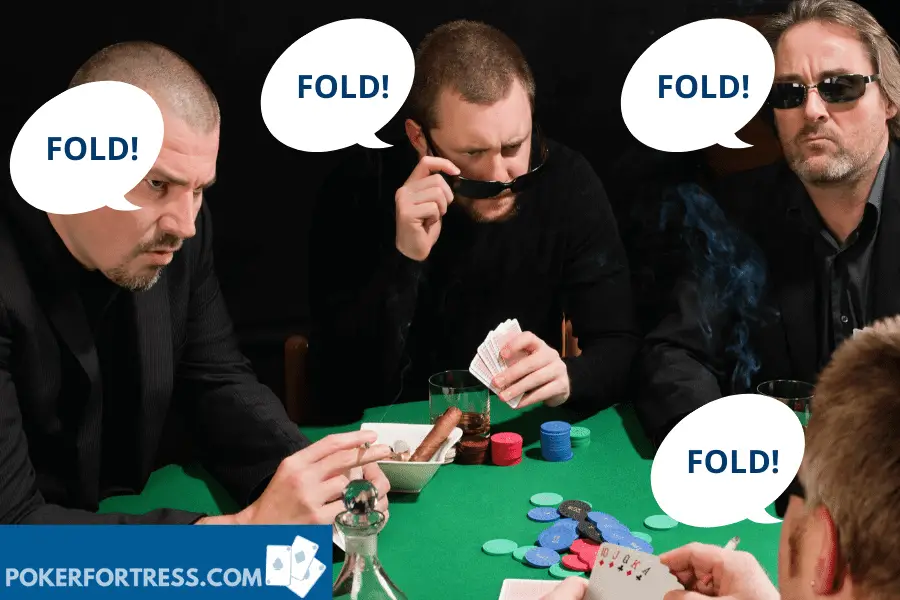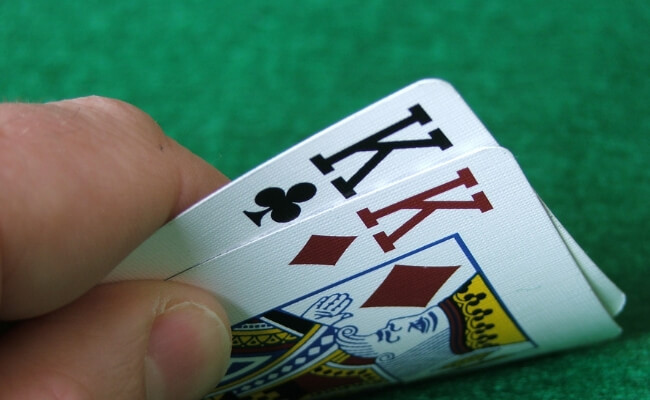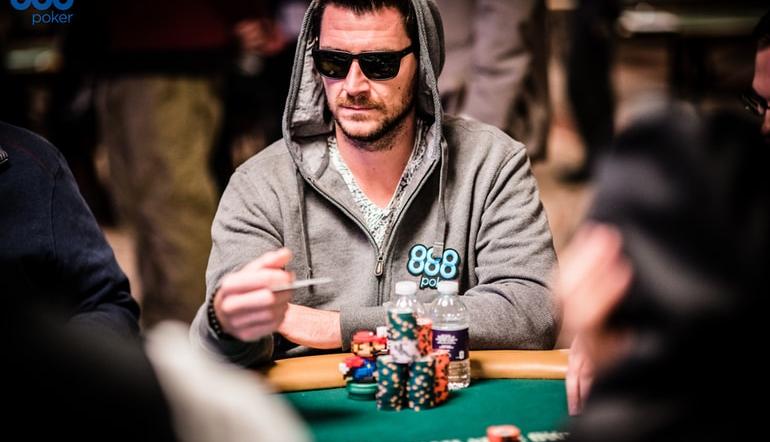In this instance, given the fact that the number of video poker variations of a full house I would fold is exactly zero, I decided to raise again because you would be absolutely shocked how much video poker and No-Fold’em-Hold’em seem the same at 4am by your sixth shot of rum. The term fold in poker means to give up your cards and forfeit the game. A player has the option to fold their cards and forfeit the game at any point in the game. The fold in poker meaning remains the same in any sort of poker game- Texas Hold’em, four card poker, Omaha or others, the meaning of fold in poker remains the same. As a noun, the muck refers to the pile of discarded cards lying on the table. As a verb, mucking means to fold your hand. Most often, the word is used at the end of a hand when a player is faced with a decision on whether to show his cards or “muck” them. Simply understanding the concept of mucking in poker is one thing. Isolate – To make a raise with the intention of forcing others to fold in hopes of being able to play heads up against a single opponent is to isolate him. Limp – To just flat call the amount of the big blind is to limp into a hand. Monster – A very strong hand that is almost certainly the winner. Muck – Folding your hand is to muck it.
A new reader, Alex, wrote today to ask how the order of betting works in poker. She’s interested in learning how to gamble, she says, but she doesn’t understand this essential factor of poker. She also asked how do you know when to bet, check, fold, or raise.These might be the 2 most important factors in poker besides understanding the standard ranking of poker hands.
And like most seemingly easy questions, the answers to these questions are more complicated than you might think. When it comes to how the order of betting works in poker, it depends on which game you’re playing. Luckily, most poker games can be sorted into 3 categories, and within each category, the order of betting is more or less the same.
When it comes to knowing when to bet, check, fold, or raise—well, there are 2 ways to answer that question. The first answer is simple enough—you know when to bet, check, fold, or raise when it’s your turn—not before, please.
The 2nd answer is more complicated, because it looks at the question from a different perspective. In that case, we’re talking about “which situations” when we use the word “when.”
I’ll address all these aspects of these 2 questions in this post.
Let’s Start with the Possible Betting Actions You Can Take
In poker, you’re always choosing just one of the following options when it’s your turn to bet:
- Checking
- Betting
- Raising
- Calling
- Folding
When no one else has bet yet, checking is an option. This means you’re not risking any money, but you want to stay in the hand. If everyone else checks, you move on to the next round of the game. Most of the time, though, someone will bet. When it comes back to your turn again, you’ll have to decide what to do then.
Betting is when you’re the first person to put money into the pot. The other players have to decide whether to call or raise your bet. They also have the option of folding.
Calling is when a player acts after you and puts in the same amount of money you bet. You’re both still in the hand at this point, and that money goes into the pot.
Raising is when you call your opponent’s bet but add to it. You usually need to raise the same amount as the initial bet. The original bettor has to match your raise to stay in the hand. He can also re-raise.
Folding means to drop out of the hand. You don’t have to put any money into the pot, but you also forfeit your hand and any claim to the pot.
The most basic form of poker that almost everyone learns to play as a child is 5 card draw. In 5 card draw, each player gets 5 cards, all of which are dealt face down. There are 2 rounds of betting—you get to bet on your initial hand. After that round of betting, you get to discard and replace cards in your hand. This is followed by a 2nd round of betting and possibly a showdown.
Most people only play 5 card draw in home poker games these days. You’re required to put up a forced bet (called an ante) before getting a hand. In most home poker games, the position of dealer rotates around the table after each hand.
The word “open” in this context means to place the 1st bet. Until someone places a bet, the players have the option to “check” their hand. This means they don’t risk any money, but they’re still in the hand. Once someone opens the betting, players who checked previously eventually (when it’s their turn) get to decide whether to call, fold, or raise.
When Should You Bet, Call, Fold, or Raise in 5 Card Draw Poker
In most games of poker, including 5 card draw, calling is usually a mistake. Poker rewards aggression, so most of the time, you should bet or raise. If you’re not feeling good enough about your hand to bet or raise, you should check or fold. Calling is a weak move.

In most home poker games of 5 card draw, you’ll see a lot of players limping. That’s the wrong way to play. If you bet and raise when everyone else is limping, you’ll come out ahead in a lot of home poker games.
You might also draw to a flush or to a straight, but you only do this if you’re going to be in the pot with at least 2 or 3 other players. If you don’t have enough other players in the pot with you, you won’t get paid off if you make your hand. This is the exception to the “don’t limp” strategy I mentioned earlier.
Depending on the strength and tendencies of your opponents, you might sometimes bluff if you have nothing. This means betting or raising even though your opponent might have you beat. This works best when you know your opponent is weak. It also helps to have a reputation as a tight aggressive player.
The Order of Betting in Holdem Games (Community Card Poker Games)
The most popular poker game in most home games and most casinos now is Texas holdem, but it’s only one in a broader category of games called “community card” games or “holdem games.” In common parlance, when someone mentions holdem, they’re usually referring to Texas holdem. But the proper name for Omaha is “Omaha holdem.”
Regardless of which variation you’re playing, the order of betting is more or less the same from one holdem game to another.

One of the differences between holdem games and draw poker games is the forced bet. In 5 card draw, everyone puts up an ante before getting any cards. (This is also true in most stud games.)
The dealer button and the blinds determine the betting order in holdem games. And there are 4 rounds of betting in holdem games.

The 1st round of betting comes after everyone gets their face down cards in their own hands. The 2nd round of betting comes after the flop, which is when the 1st 3 community cards are dealt. There’s another round called the turn where a 4th community card is dealt. And finally, there’s a river card—the last of the 5 community cards.

All holdem games have 5 community cards dealt in that order. The differences between holdem games have to do with how many hole cards you get and what combination of hole cards and community cards you have to use to make your final hand.
Before the flop, the betting begins with the player to the left of the big blind. (There are 2 blinds—big and little. The sizes of these blinds vary based on the limits.) This means that the player in the big blind acts last.
During all the subsequent betting rounds, the blinds are the first players to act, starting with the small blind. Betting rotates around the table in clockwise order, which means you act immediately after the player to your right has acted.
Fold In Poker Means
When Should You Bet, Call, Fold, or Raise in Holdem Poker
Okay, this is where things get complicated. The short, practical answer is the same:
When it’s your turn. But let’s talk a little bit about tight aggressive player.
What Does It Mean To Fold In Poker
New players probably benefit from learning a tight aggressive strategy. Loose aggressive players do well, too, especially in no limit games—but for the beginner, tight aggressive is better.
What does this mean?
Fold In Poker Means Play
A tight player only plays good hands. He folds a lot. This means you should fold unless you have a better than average hand. You should also fold if you have a marginal hand but in a lousy position. If you play a lot of hands, you’ll usually lose money. Players who participate in lots of hands are called loose players.
An aggressive player bets and raises when he’s in a hand. If you just check and call, you’re a passive player. Aggressive players make more money because they pick up a lot of dead money when they win pots uncontested. They also make more money when they have good hands because they’ve been actively increasing the sizes of the pots.
So if you’re a beginner, how do you know what to do in which situation?
Also, holdem is a game that’s determined after the flop, too. If the flop doesn’t fit your hand, don’t be afraid to fold when the flop hits. Don’t keep putting money into the pot unless you think you have a reasonable chance of winning a showdown or of running everyone else out of the pot.
The most popular variations of stud poker now played in casinos are 5 card stud and 7 card stud. These games feature face up cards and face down cards, but no one shares cards. You play the cards in your hand.

The action in a stud poker game happens in streets. The first betting round happens after the first 2 cards are dealt (in 5-card stud) or after the first 3 cards dealt (in 7-card stud). After that, there’s a round of betting after each card.
Unlike in holdem and draw poker games, who acts first can change from betting round to betting round. Like draw poker games, stud poker games usually involve a forced bet from every player called an ante.
The first person to act in the first round is the player with the lowest card showing face up. He can either make another bet that’s the same size as the bring-in, or he can raise it to a full-sized bet. (In other words, he adds an additional amount to his ante bet that he already placed.) Betting proceeds to his left.
On the other streets, the first person to act is the person with the best poker hand showing on his face up cards. The order can change on every street, or it can remain the same. It just depends on where the cards land.
When Should You Bet, Call, Fold, or Raise in Stud Poker
Just like with every form of poker, you should always wait until it’s your turn to take your betting action.
If you don’t have something after getting your first 2 or 3 cards, you should almost always fold. It’s hard to win at poker if you keep putting money in the pot when you’re not the lead horse in the race.
You make decisions based on when to bet or raise based on how likely you are to have the best hand. If you have high cards, you should play aggressively.
But if you’re playing speculative hands—flush draws or straight draws—you need to pay attention to whether your cards are live. If you’re drawing to a flush, but 3 cards or more of the suit you need are already out there, you’re drawing dead. It’ll be hard to make your hand.
One of the advantages you can gain in poker is positional. The later you act, the more information you have about the other players and their cards. If you act before it’s your turn, you give up that advantage.
It’s also considered rude.
Just wait until it’s your turn to act, dude.
Conclusion
Knowing when to act in poker is easy. You just need to know which version of poker you’re playing:
- Draw poker
- Holdem poker
- Stud poker
Fold In Poker Means Meaning
Betting always moves clockwise around the table. The changes that matter depend on who bets first. Once you know how that works for each variation, you’re all set.
Deciding what to do and why is the subject of every poker strategy book ever written. But in general, I suggest playing a tight aggressive game. Get good cards, bet them hard, and fold everything else.
If you’re just starting, that approach will do more to help you win money than anything else.